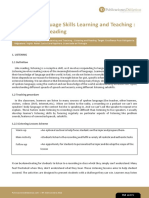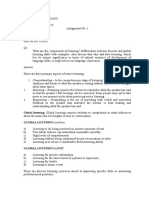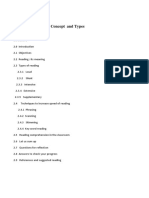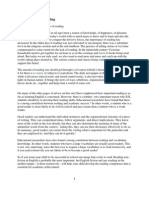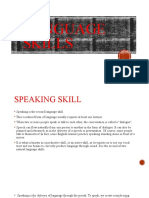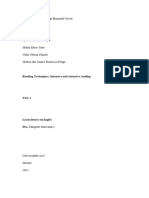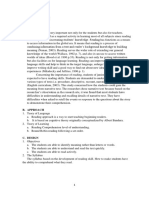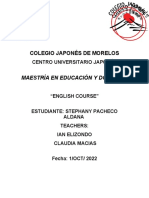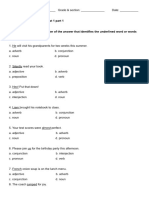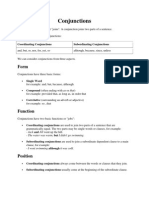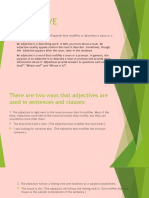Receptive Language Skills Learning and Teaching: Listening and Reading
Receptive Language Skills Learning and Teaching: Listening and Reading
Uploaded by
ericabalan94Copyright:
Available Formats
Receptive Language Skills Learning and Teaching: Listening and Reading
Receptive Language Skills Learning and Teaching: Listening and Reading
Uploaded by
ericabalan94Original Title
Copyright
Available Formats
Share this document
Did you find this document useful?
Is this content inappropriate?
Copyright:
Available Formats
Receptive Language Skills Learning and Teaching: Listening and Reading
Receptive Language Skills Learning and Teaching: Listening and Reading
Uploaded by
ericabalan94Copyright:
Available Formats
View metadata, citation and similar papers at core.ac.
uk brought to you by CORE
provided by PublicacionesDidácticas (E-Journal)
Receptive Language Skills Learning and Teaching :
Listening and Reading
Título: Receptive Language Skills Learning and Teaching : Listening and Reading. Target: Enseñanza Post-Obligatoria.
Asignatura: Inglés. Autor: Lucia Carel Aguilera, Licenciada en Filologia
1. LISTENING
1.1 Definition
Like reading, listening is a receptive skill, as it involves responding to language rather than producing it.
Listening involves making sense of the meaningfulsounds of language. Learners do this by using context and
their knowledge of language and the world. In fact, we do not listen to everything in the same way. How we
listen depends on our reason for listening. We might listen for gist, specific information, detail, attitude or do
extensive listening. We can observe that listening involves doing many things: dealing with the characteristics
of spoken language; using the context and our knowledge of the world; understanding different text types;
understanding different speeds of speech and accents; using different listening subskills.
1.2 Teaching procedure
In the classroom, learners can listen to many sources of spoken language (the teacher, other learners,
visitors, videos (DVD, Internet,etc.). When we listen to the radio, a recording or a podcast we can't see
speakers' body language or the context he/she is speaking in. And we can't ask the speaker to repeat or to
explain. These factors make listening to recordings more difficult than listening to live speakers. I usually
develop learner's listening skills by focusing regularly on particular aspects of listening like problem
sounds,features of connected speech, subskills.
1.2.3 Listening Lessons Scheme
Warm up •An optional section to help focus students on the topic and prepare them.
Main Activity •Students listen to the recording and fulfil a variety of realistic and authentic tasks
Follow up •An opportunity for students to personalise the topic and develop the scope of the
lesson
It can be demotivating for students to listen to a recording in class which they simply can't understand. Many
feel frustrated when they don't understand what they hear. These Listening lessons aims to help student
succeed. The activities are designed to present students with a challenge they can win. Learners may listen
Publ icacionesDidacticas.com | Nº 32 Di ci embre 2012
153 de 371
several times to the recording, often listening for different information each time. I help my students by
encouraging them to pool their knowledge about the topic before they listen. This helps to focus their mind and
prepares them for the recording. A list of key words and language patterns are provided, so I pre-teach these
items students need not be confused by unfamiliar words. Language is presented in familiar and authentic
contexts. By relating these contexts to their own real-world experience, learners can see the value of the
listening activity and become more motivated. Listening is an active process and students need to think and
interpret what they hear as they listen. The activities in this syllabus encourage students to react to what they
hear as naturally as possible. Learners are encouraged to think around the recording , too, by listening between
the lines for emotions and opinions, or picking up on aural clues in the background. Listening sessions highlight
the main listening strategies employed in each activity. However, it is of course natural for learners to employ a
combination of several different skills in the course of a single listening. Therefore, those skills highlighted
simply refer to the main skills focused on by each activity type like:
1. Listening for specific information: learners identify certain key information at word level.
2. Listening for details: students listen for phrases and longer strings of information at sentence level.
3. Listening for the main idea: they listen to the complete recording in order to understand core ideas
4. Listening for opinions: they listen to understand the views expressed by a particular speaker
5. Inferring meaning: they 'listen between lines' to understand what the speaker is really saying
6. Recognising context: learners listen around the recording to identify where it takes place, who the
people are, etc.
7. Predicting: students anticipate what they will hear before the recording is played
8. Identifying emotion: they listen to identify the mood of a particular speaker.
2. READING
2.1 Definition
Like listening, reading is a receptive skill and this fact involves responding to text, rather than producing it,
reading involves making sense of text. To do this we need to understand the language of the text at word level,
sentence level and whole-text level. Learners also need to connect the message of the text to their knowledge
of the world.
The main difficulty remains on using students' knowledge of the world to see the connection between two
sentences (coherence), the grammatical links between the sentences (cohesion) also helps us to see the
connection between them. When we read we do not necessarily read everything in a text. What we read
Publ icacionesDidacticas.com | Nº 32 Di ci embre 2012
154 de 371
depends on why and how we are reading. For example, we may read a travel website to find a single piece of
information about prices. But we may read a novel in great detail because we like the story and the characters
and want to know as much as we can about them. Our reasons for reading influence how we read, which
reading subskill we use:
• Reading for specific information or scanning: reading a text just to find a specific piece or pieces of
information
• Reading for gist or skimming: reading quickly through a text to get a general idea of what is about
• Reading for detail: getting the meaning out of every word.
• Extensive reading: it involves reading long pieces of text. This part is fully explained in the Readers' part.
2.2 Teaching procedure
If learners know how to read in their own language, they can transfer their reading skills to reading English.
Sometimes, they find this difficult so givinglearners lots of opportunities for extensive reading, in or out of
class, helps them to develop their fluency in reading.
The texts chosen are devoted to interest learners in order to motivatre them through current topic or news
that they can easily know about wiyh realia. In this level of English, learners read articles, brochures, etc. that
are what a first language speaker would read, in other words: authentic material
2.3 Reading Lessons Scheme
The lesson is divided into three stages:
Warm up •Introduction of the topic of the lesson.
Main Activity •Revision/introduction of essential vocabulary items
•Students read the text(s) and carry out related tasks
Follow up •Students make own personalised response to the text(s)
•Students research further reading material about the topic
The teacher has two roles in the reading classroom. Particularly at the beginning of the lesson, the teacher is
the centre of the action : initiating discussion, handing out materials, giving instructions, checking feedback.
But while the reading is actually going on, the teacher's role is that of monitor, supporter and advisor. It is the
students themselves who must do the reading.
But this does not mean that the reading classroom should be a silent place. In the real world, we often
discuss things we have just read. Similarly, we ask for clarification if there is something we have not
understood. To reflect the real world, and to encourage the on-going process of learning, I allow and
encourage students to work together in pairs while they are reading the same text.
Publ icacionesDidacticas.com | Nº 32 Di ci embre 2012
155 de 371
Our classroom is a well-equipped one providing each student with easy access to an English/English
dictionary. At the same time, students will be encouraged to turn to the dictionary to look up an unknown
word only as a last resort or to check their prediction – they have the context of the word to help with its
meaning, they have their classmates to offer support and advice, they have the teacher to point them in the
right direction. ●
Bibliografía
Cravem, M.2010. Listening Extra. Cambridge:CUP
Driscoll, L..2010. Reading Extra. Cambridge:CUP
Lightbown, P.2006. How Languages are Learned, Oxford:OUP
Marsland,B.2009. Lessons from Nothing. Cambridge: CUP
Scrivener, J. 2005. Learning Teaching: The Essential Guide to English Language Teaching. Oxford: Macmillan
Education
Spratt, M; Pulverness, A. &Williams, M.2011. The TKT (Teaching Knowledge Test) Course. Cambridge:CUP
Publ icacionesDidacticas.com | Nº 32 Di ci embre 2012
156 de 371
You might also like
- Word Roots 4 - Cherie A. PlantDocument337 pagesWord Roots 4 - Cherie A. PlantCelina Jade100% (1)
- High Valyrian VocabDocument5 pagesHigh Valyrian VocabvraamapriyaNo ratings yet
- Cambridge Latin Course Unit 1 Workbook PDFDocument4 pagesCambridge Latin Course Unit 1 Workbook PDFafiwhlkrm100% (2)
- Fifty Ways to Teach Reading: Fifty Ways to Teach: Tips for ESL/EFL TeachersFrom EverandFifty Ways to Teach Reading: Fifty Ways to Teach: Tips for ESL/EFL TeachersRating: 4 out of 5 stars4/5 (3)
- Active and PassiveDocument16 pagesActive and PassiveRamalakshmi RamaNo ratings yet
- Training For DeltaDocument4 pagesTraining For DeltaViyal CorNo ratings yet
- ReadingListening KeyIdeasDocument5 pagesReadingListening KeyIdeasSamira Alves GülüNo ratings yet
- Teaching Receptive and Productive SkillsDocument37 pagesTeaching Receptive and Productive SkillsNurul HanisahNo ratings yet
- SPEC ReportDocument34 pagesSPEC ReportAbegail Dela CruzNo ratings yet
- Reading ApproachDocument26 pagesReading ApproachJennylyn SagradoNo ratings yet
- The Language Skills 1 TEFL AIOUDocument24 pagesThe Language Skills 1 TEFL AIOUPrince Kazmi100% (1)
- Makalah NewDocument11 pagesMakalah NewAnida Riyanti50% (2)
- The Teaching of ListeningDocument18 pagesThe Teaching of ListeningJanita NikolivaNo ratings yet
- MetoDocument12 pagesMetoRana QuliyevaNo ratings yet
- Teaching Reading: Methods and Techniques For Teaching English IDocument23 pagesTeaching Reading: Methods and Techniques For Teaching English IJamilah VzqzNo ratings yet
- Môn Phương pháp giảng dạy tiếng Anh Bậc Trung họcDocument10 pagesMôn Phương pháp giảng dạy tiếng Anh Bậc Trung họcTrần HoàngNo ratings yet
- Final Project Reading: Student's Name: Lizeth Mezquite ReyesDocument30 pagesFinal Project Reading: Student's Name: Lizeth Mezquite ReyesLizeth ReyesNo ratings yet
- The Language Skills-I 5659Document25 pagesThe Language Skills-I 5659mubarak201160% (5)
- A Framework For Planning A Listening Skills LessonDocument10 pagesA Framework For Planning A Listening Skills LessonMa Eugenia Amezquita AcostaNo ratings yet
- Phase 3.1 Teaching Techniques (Language Skills)Document60 pagesPhase 3.1 Teaching Techniques (Language Skills)Madhuri KarnewarNo ratings yet
- Understand Language Skills READING AND WRITINGDocument11 pagesUnderstand Language Skills READING AND WRITINGSunil SagarNo ratings yet
- Teaching Reading & Listening - Group 3Document52 pagesTeaching Reading & Listening - Group 3Khoa KhươngNo ratings yet
- Reading & Listening Activities: Module SummaryDocument2 pagesReading & Listening Activities: Module SummarySultan DidiNo ratings yet
- Block 3 Unit 2 Reading: Concept and Types: StructureDocument25 pagesBlock 3 Unit 2 Reading: Concept and Types: StructureIlyas AbidNo ratings yet
- The Importance of ReadingDocument39 pagesThe Importance of ReadingyousufbaiNo ratings yet
- SSW 10Document3 pagesSSW 10Ayana BadyrovaNo ratings yet
- Teaching ReadingDocument14 pagesTeaching Readingangelito pera100% (1)
- Resumen SkimmingDocument4 pagesResumen Skimmingdiegouni2024No ratings yet
- Module 3.2 - Listening and ReadingDocument18 pagesModule 3.2 - Listening and ReadingThuonggipNo ratings yet
- INTRODUCTIONDocument12 pagesINTRODUCTIONAstenaLargamaNo ratings yet
- AhDocument21 pagesAhDee EdNo ratings yet
- TALLER3 A - Framework - For - Planning - A - Listening - Skills - Lesson - Nik - Peachey PDFDocument4 pagesTALLER3 A - Framework - For - Planning - A - Listening - Skills - Lesson - Nik - Peachey PDFCandeENo ratings yet
- FLen I Handout 222Document74 pagesFLen I Handout 222keyradinyekasiNo ratings yet
- Anwar HossenDocument13 pagesAnwar HossenAvro Abir AbirNo ratings yet
- Ten Steps To Effective Listening: Taking Notes Analyzing and Synthesizing What Is Read Figurative LanguageDocument4 pagesTen Steps To Effective Listening: Taking Notes Analyzing and Synthesizing What Is Read Figurative LanguageLydia ElaNo ratings yet
- Teaching ListeningDocument35 pagesTeaching ListeninglugarinigiulianaNo ratings yet
- Language SkillsDocument39 pagesLanguage SkillssairaNo ratings yet
- A Chapter Reports of Harmers 2007 ChapteDocument11 pagesA Chapter Reports of Harmers 2007 ChapteMuhammad HamdyNo ratings yet
- English 123Document4 pagesEnglish 123Avro Abir AbirNo ratings yet
- R. MethodsDocument10 pagesR. MethodsFilimao ChichavaNo ratings yet
- Analysis Syllabus CMD Group 2Document6 pagesAnalysis Syllabus CMD Group 2beell beellaaaNo ratings yet
- Hard Copy ETMDocument5 pagesHard Copy ETManis thahirahNo ratings yet
- 02 Tamara - 29 Agustus 2023Document60 pages02 Tamara - 29 Agustus 2023annisakurniaasriNo ratings yet
- Alumno: Especialidad: Ciclo: Tema:: The Four SkilsDocument8 pagesAlumno: Especialidad: Ciclo: Tema:: The Four Skilsgerli carrasco sanchezNo ratings yet
- Notes On Reading Strategies-1Document13 pagesNotes On Reading Strategies-1Umar Niazi OfficialNo ratings yet
- Teaching ReadingDocument11 pagesTeaching ReadingVen KeraNo ratings yet
- Teaching Method - Reading Approach 2Document8 pagesTeaching Method - Reading Approach 2djoiajgNo ratings yet
- Teaching of Reading 1Document5 pagesTeaching of Reading 1Syrile MangudangNo ratings yet
- Seminar of LanguageDocument34 pagesSeminar of LanguageJulia RheintanataNo ratings yet
- Assignment English 2037Document24 pagesAssignment English 2037ISLAH INTERNATIONALNo ratings yet
- Extensive ReadingDocument8 pagesExtensive ReadingRia WiniamsyahNo ratings yet
- Module 5 - Teaching and Asessemend of Literature StudiesDocument4 pagesModule 5 - Teaching and Asessemend of Literature StudiesFrancis Sam SantanezNo ratings yet
- What Is Listening Skill?Document5 pagesWhat Is Listening Skill?Elsa VargasNo ratings yet
- Portfolio: Teacher: Hernan Arteta Student: Adriana Ramos Met 4 Icpna May 21th, 2021Document21 pagesPortfolio: Teacher: Hernan Arteta Student: Adriana Ramos Met 4 Icpna May 21th, 2021jeanet ramosNo ratings yet
- Language Skills Development in The Efl ClassroomDocument191 pagesLanguage Skills Development in The Efl ClassroomDilbara KonurbaevaNo ratings yet
- Unit3 Mod2 180 RMDocument45 pagesUnit3 Mod2 180 RMkhannaharishNo ratings yet
- ESOL Strategies Matrix A. Listening A1. LEA (Language Experience Approach)Document17 pagesESOL Strategies Matrix A. Listening A1. LEA (Language Experience Approach)attar8No ratings yet
- Investigation PrepositionsDocument9 pagesInvestigation Prepositionsstephany pachecoNo ratings yet
- 3 R Eceptive Skills: Reading: How Can You Help Your Students Improve Their Reading?Document5 pages3 R Eceptive Skills: Reading: How Can You Help Your Students Improve Their Reading?Anita MadunovicNo ratings yet
- The Text - PresentationDocument35 pagesThe Text - PresentationMarijanaNo ratings yet
- ENH 508 Part 1Document34 pagesENH 508 Part 1arefinakashnkNo ratings yet
- Chapter VI Reading and WritingDocument27 pagesChapter VI Reading and WritingYsmael Villarba CabansagNo ratings yet
- LECTURE 11 Intercultural Speech - Activity Bases of Communication On The Basis of Listening Plan - 1Document16 pagesLECTURE 11 Intercultural Speech - Activity Bases of Communication On The Basis of Listening Plan - 1crazyjupiterdaysNo ratings yet
- Past Simple Present Perfect: "Ed" Irregular Verbs Must Be Learnt by HeartDocument2 pagesPast Simple Present Perfect: "Ed" Irregular Verbs Must Be Learnt by HeartSolomiiaNo ratings yet
- Lecture10 - Integrating The Four Skills PDFDocument35 pagesLecture10 - Integrating The Four Skills PDFNur Aliaa AjlaaNo ratings yet
- Middle EnglishDocument3 pagesMiddle EnglishzacNo ratings yet
- Lecture 01 What Is Technical English StudentsDocument7 pagesLecture 01 What Is Technical English Studentsbenhammaahmed70No ratings yet
- Sociolinguistics and English Language Education in Nigerian Higher InstitutionsDocument19 pagesSociolinguistics and English Language Education in Nigerian Higher InstitutionsOdukoya AdeniyiNo ratings yet
- A2 UNIT 2 Test Answer Key StandardDocument2 pagesA2 UNIT 2 Test Answer Key StandardMartu Romero100% (1)
- ACP Grade 7Document3 pagesACP Grade 7Abdul Basit SkNo ratings yet
- Dialogue 1-3 Formal IntroductionsDocument36 pagesDialogue 1-3 Formal IntroductionsAngelou GarciaNo ratings yet
- Regular and Irregular Plural Nouns inDocument7 pagesRegular and Irregular Plural Nouns inUyen VoNo ratings yet
- CHAPTER III KLS XI Prtmuan 2Document6 pagesCHAPTER III KLS XI Prtmuan 2Rizki CahyaNo ratings yet
- Lesson - 20: Standing FathahDocument53 pagesLesson - 20: Standing FathahKarim AlGafarawyNo ratings yet
- Research QuestionsDocument12 pagesResearch Questions12 John Paolo DumaguinNo ratings yet
- Sample Lesson Plan - LexisDocument4 pagesSample Lesson Plan - Lexisngocthuong1609No ratings yet
- Nihms 267813Document19 pagesNihms 267813Poonam joshiNo ratings yet
- ConjunctionsDocument6 pagesConjunctionsJervin CoronelNo ratings yet
- Linking Words - Part 1Document7 pagesLinking Words - Part 1teaNo ratings yet
- Types of PronounsDocument11 pagesTypes of PronounsReynaldo Aluyen Guinoden Jr.No ratings yet
- Lecture 27. WORD ORDER 1. Word Order in English Is of Much Greater Importance Than in Russian. Due To TheDocument12 pagesLecture 27. WORD ORDER 1. Word Order in English Is of Much Greater Importance Than in Russian. Due To TheМария АрнаутNo ratings yet
- Adjective: What Is An Adjective? Adjective (Noun) : A Part-Of-Speech That Modifies or Describes A Noun or A PronounDocument27 pagesAdjective: What Is An Adjective? Adjective (Noun) : A Part-Of-Speech That Modifies or Describes A Noun or A PronounRoo LuuNo ratings yet
- Present Simple To BeDocument7 pagesPresent Simple To BeЈелена БогићNo ratings yet
- Brothers Grimm Bilingual Spanish EnglishDocument484 pagesBrothers Grimm Bilingual Spanish Englishraulhoh100% (1)
- Lesson Plan - Ecrif - 41 - JAEDocument2 pagesLesson Plan - Ecrif - 41 - JAEKEVIN STALYN CAMBO MARTINEZNo ratings yet
- Contextual Augmentation: Data Augmentation by Words With Paradigmatic RelationsDocument6 pagesContextual Augmentation: Data Augmentation by Words With Paradigmatic Relationschloe trumpNo ratings yet
- Talking About The FutureDocument19 pagesTalking About The Futurehoracio4espinoza4calNo ratings yet
- Table of Specification 1st QuarterDocument8 pagesTable of Specification 1st QuarterDIANNE CHARISH CABUYAONo ratings yet
- Anikin Et Al 2023 Do Some Languages Sound More Beautiful Than OthersDocument7 pagesAnikin Et Al 2023 Do Some Languages Sound More Beautiful Than OthersNam CaoNo ratings yet





